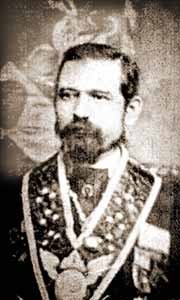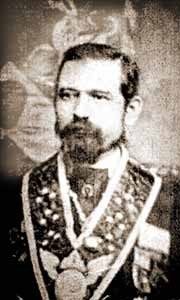by Richard Kaczynski
As the person who chartered Theodor Reuss, Franz Hartmann, and Henry Klein to start an Academia Masonica for the German empire, and who authorized Aleister Crowley to restart the Antient and Primitive Rite, John Yarker is the lynchpin in the establishment of Ordo Templi Orientis.
John Yarker (1833–1913) was born in Swindale Shap, Westmoreland. At an early age, he and his family relocated to Lancashire then Manchester, where he would live out the rest of his life. He worked as an import/export merchant and a yarn or cloth agent.
He was interested in Freemasonry in all its forms from an early age. He took his Entered Apprentice (1°) in Lodge of Integrity No. 189 (now 163) on October 25, 1854; after a mandated three-month waiting period, he was promptly Passed and Raised on February 16 and April 25, respectively. He would serve as Secretary, Junior Warden and Worshipful Master within the following three years. He also took a keen interest in appendant and high-degree rites, including those of Mark Masonry, the Royal Arch, Ancient Accepted Rite, and Knights Templar. His first book was dedicated to his Templar encampment: Notes on the Orders of the Temple and St. John and the Jerusalem Encampment, Manchester (1869).
In the archives of the Jerusalem Conclave, Yarker found the relics of a forgotten history of Freemasonry, including records of rituals long since abandoned or forgotten. This precipitated his lifelong obsession with Masonic archaeology. He became a prolific writer of books, along with articles, notices and letters to Masonic—and, as we shall see, occult—journals. All of this earned him a reputation not only as one of the most learned historians of Masonry, but also as one of the most opinionated. While his friends embraced his encyclopedic knowledge, his detractors found him abrasive and credulous.
Because most high degree rites were compilations of older, independent ceremonies, Yarker concluded that these rites had no basis for claiming exclusivity over their constituent rituals: the individual rituals were the creations of others, and did not belong to the rites that later adopted them. This belief brought Yarker into conflict with the Ancient Accepted Rite (AAR), from which we was ultimately expelled in 1870. He responded by founding a Supreme Council of the 33° of the Ancient and Primitive Rite under a charter from Harry J. Seymour. The AAR considered this to be a spurious version of their rite, and warned their members to steer clear of it under threat of expulsion. Yarker’s rites would prove to be an ongoing bone of contention, with Yarker verbally sparring with Albert Pike over these issues as late as the 1880s. In the end, the Ancient and Primitive Rite was never a threat to the AAR, and subsisted through the dues payments of a small cadre of dedicated members with Yarker making up the difference out of his own pocket.
In time, Yarker would also add the Cerneau Scottish Rite and the Swedenborgian Rite to his sizable portfolio of authorities, along with obscurities like the Rite of Ishmael, Red Branch of Eri, Sat Bhai, and Ancient Order of Zuzumites. In 1884, he also began publishing The Kneph, which was the “Official Journal of the Antient and Primitive Rite of Masonry.”
Despite his ongoing conflict with the AAR, Yarker remained a Mason in good standing. He joined the scholarly and prestigious Quatuor Coronati correspondence circle in May 1887 as member number 77; he would remain a member, and contribute regularly to its journal, Ars Quatuor Coronatorum, for the rest of his life.
Like many of his colleagues, Yarker was also interested in occultism. Craft Masonry was his gateway drug, and between 1876 and 1878 he conducted an “experimental enquiry on Crystallomancy, Mesmerism and Occultism.”1) William L. Cummings confirms this, recalling that
[Yarker] seems to have been familiar with everything that had been written dealing with magic and confesses that he carried out some experiments in practical alchemy without obtaining any definite results. Apparently he took everything of an occult or mystical nature for his province and ran the entire gamut.2)
These esoteric interests included Theosophy: H. P. Blavatsky (1831–1891) made Yarker a Corresponding Fellow of the Theosophical Society and cited his Notes on the Scientific and Religious Mysteries of Antiquity (1872) in her Isis Unveiled (1877). At the suggestion of their mutual acquaintance Charles Southeran (1847–1902), Yarker reciprocated by bestowing honorary Masonic degrees upon Blavatsky in both Sat Bhai and Adoptive Masonry. He was also an early contributor to The Theosophist.
In addition, Yarker was a member of the Golden Dawn precursor group the Society of Eight, the Celestial Brotherhood of Charubel (John Thomas, 1826–1908), and Gérard Encausse’s (1865–1916) Martinist Order. He had connections with the Hermetic Brotherhood of Luxor—their seal adorned the first page of Yarker’s translation, Magnetic Magic (1898)—as well as Paschal Beverly Randolph (after Randolph died, Yarker paid £4 for the original manuscript to Eulis from Robert Fryar, 1845–1909). Ever the experimenter, he also found spiritual enlightenment in the experience of smoking marijuana:
It put me into a peculiar dreaming state and I felt myself at one with the Infinite Mind and whatever subject I thought of passed from the particular to the general. If I thought upon the relation existing between Man and Woman, I beheld myself a portion of the Masculine energy of nature.3)
In November 1902, Yarker advanced from being Grand Master 96° for Britain and Ireland to succeed Francesco Degli Oddi as Grand Hierophant 97°, the international head or Sovereign Grand Master General of the Ancient and Primitive Rite.
When Theodor Reuss and colleagues began collecting authority to establish the Academia Masonica that would become Ordo Templi Orientis, most of their charters came from John Yarker: On February 21, 1902, he authorized Reuss to establish a German Grand Lodge of the Swedenborgian Rite. Shortly thereafter, Yarker appointed Reuss, Franz Hartmann, and Henry Klein to the degree of Grand Curator General (95°) in honoris causa, then jointly chartered the three of them to form a Sovereign Sanctuary and “confer the several Degrees of our Antient and Primitive Rite from the First to the 33°–95° A[ntient] and P[rimitive], 90° Misraïm and 33° Antient and Accepted.”4) On July 14, 1903, the Sovereign Sanctuary of Great Britain and Ireland—pleased with the progress of the Rite in Germany—made Carl Kellner, Theodor Reuss, Franz Hartmann and Henry Klein Honorary Grand Masters in Great Britain and Ireland.
The 1909 publication of Yarker’s magnum opus, The Arcane Schools, was greeted with little fanfare. The press reception was lukewarm and his publisher reported slow sales. Yarker was therefore pleasantly surprised and struck up a correspondence when Aleister Crowley wrote in The Equinox,
The reader of this treatise is at first overwhelmed by the immensity of Brother Yarker’s erudition. He seems to have examined and quoted every document that ever existed. […]But Brother Yarker has nobly suppressed a Spencerian tendency to ramble; he has written with insight, avoided pedantry, and made the dreary fields of archeology blossom with flowers of interest.
Accordingly, we must give him the highest praise, for he has made the best possible out of that was nearly the worst possible.
He has abundantly proved his main point, the true antiquity of some Masonic system. It is a parallel to Frazer’s tracing of the history of the Slain God.5)
The correspondence would prove to be fateful for both men. For Yarker, it offered an opportunity to publish book reviews in The Equinox and to find a young man eager to carry on the work that he had shepherded for so long. For Crowley, Yarker acknowledged the 33° that he had received in Mexico in 1900 and long assumed to have been spurious, and, on November 29, 1910, recognized Crowley as 33° in the Ancient and Accepted Rite (i.e., Yarker’s Cerneau lineage, not the AAR descended from Charleston).
During this time, Yarker schooled Crowley in the politics of running a high degree rite of esoteric Masonry without running afoul of the United Grand Lodge of England. This education included the importance of dues in a membership organization. As Yarker remarked, “You will come to see […] that a dozen men, who are Craft Masons already, and will pay a reasonable fee, are worth 40 or 50 admitted haphazard, & in absolute defiance of all Constitutional and Craft regularity.”6) A few days later that he emphasized, “if we had adopted your idea of admitting everybody free, we could have had half the town, not that they would have been any good. What is bought cheap is valued at the same price.”7)
On August 7, 1912, Yarker gave Crowely dispensation to proceed with reviving London’s dormant Ancient and Primitive Rite bodies. Crowley interpreted this broadly as meaning “get something started.” And so he conferred—with Yarker’s written approval—the degrees upon the first members of the fledgling M∴M∴M∴. Crowley found the rituals to be unwieldy and unworkable, and evidently the Grand Hierophant agreed: according to Crowley, “John Yarker saw in 1911 and 1912 that his 33 degrees were themselves unworkable.”8)Crowley’s solution was to take the rituals and boil them down to a workable, reduced set of ceremonies for M∴M∴M∴:
I took the book out to the Sahara and read it. I had only one or two other books with me. Forwards and backwards, for months on end. Who is going to commit to memory all these egregarious discourses in present day conditions? So I fished out the very sparse plums and put the whole of Masonry and super-Masonry in the rituals of O.T.O. The system is very simple. The speeches are short and specially written so as to make it all easy to memorize.9)
While Yarker left no written statement on this matter, Crowley reports that “Yarker was delighted, but died even before I had finished the work.”10)
John Yarker died of senile decay, fibroid phthisis, and cardiac failure on March 20, 1913. His manuscript on the History of the Knights Templar was in his printer’s hands at the time, and a revised edition of Arcane Schools had been prepared. In addition, Crowley had promised in The Equinox that Yarker’s translation of du Potet’s Magic Unveiled was awaiting publication.11) Alas, none of these books was ever published.
Read the original essay with references and footnotes here: https://hermetic.com/sabazius/john-yarker


